
Let’s visit again one of your humble blogger’s favorite new ships.
Critics may just call it a “jobs program” or “busy work” to keep a yard open.
The contract award represents at least a temporary continuation of Austal’s shrinking aluminum shipbuilding production lines. The company, an American subsidiary of the eponymous Australian shipbuilder, for roughly two decades had built only aluminum-hulled vessels at its shipyard in Mobile, Ala. But, in 2022, Austal was able to open $100 million-worth of steel shipbuilding facilities following a deal with the Pentagon to help kickstart the expansion.
Since then, the company has scored several notable contracts using its new facilities, such as the Coast Guard’s Offshore Patrol Cutter.
In addition to the three EMS, Austal’s aluminum-based construction efforts remaining include two Independence-class Littoral Combat Ships and three Expeditionary Fast Transports. The company is also using aluminum to build the deck houses for the Coast Guard’s new cutters and certain aircraft elevators that HII’s Newport News Shipbuilding will install on the Gerald Ford-class aircraft carriers.
“EMS may be the last aluminum ship we build,” said Ryder. “But that’s years into the future and it’s hard to tell where things will be.”
Ahem. Don’t make me like these ships more than I already do. Every yard saved is an act of patriotism.
Soft power … goodwill on a planet short of if … a nice medical capability to support what the USMC wants to do in the Pacific … something to make our friend Jerry Hendrix happy … all good reasons for you to love this as much as I do:
The design of the Bethesda-class EMS is based on Austal’s Expeditionary Fast Transport (EPF) ship. The vessel will be constructed on the company’s aluminium manufacturing line after the completion of the last EPF 16.
The EMS will feature a catamaran hull and will be 361ft in length. It will have a beam of 103ft and a draft of 15ft.
The ship will be capable of reaching speeds of more than 18 knots with a range exceeding 5,000 nautical miles when fully loaded and maintaining 15 knots in Sea State 5.
The shallow draft of the EMS will allow for greater accessibility to austere ports and offload sites, thereby enhancing the ship’s reach.
Furthermore, the ship’s manoeuvrability enables it to dock in smaller, shallower ports, increasing the number of patients that can be reached and treated.
Facilities onboard Bethesda-class expeditionary medical ships
The EMS will have a single-deck layout optimised for the flow of trauma patients and provide a Role 2E level of care. It will accommodate a crew, medical detachment, and aviation detachment totalling 223 personnel.
The ships will include 34 acute care beds, six acute isolation beds, 14 intensive care unit (ICU) beds, six ICU isolation beds, 12 recovery beds, and three operating rooms, in addition to seating for 170.
It will also feature a large flight deck capable of handling military aircraft such as the V-22 Osprey combat aircraft, CH-53K heavy-lift cargo helicopter and H-60 military helicopter, apart from a hangar and service facilities for H-60-sized aircraft.
Furthermore, the ship will be capable of conducting boat operations with two 11m rigid-hulled inflatable boats for patient transfer and recovery from water.
With the shortage of civilian mariners being so acute that we’re soft-mothballing over a dozen USNS ships, it gives me pause—but I don’t care. Let’s build them, and we’ll figure it out later.
We have three paid for, and I’ll take three more—quickly. More faster.
The first EMS is expected to begin construction in spring 2025, and a year later the company is scheduled to deliver its last EPF, Ryder said. The final EPFs in the production line are also being outfitted with limited medical support capabilities similar to those slated for installation on the EMSs.
When asked if the three ships represent the entire program of record, a Navy spokesperson told Breaking Defense after this report was originally published that the three hulls “are a program of record; and they are the ones associated with the award. Currently, there are no additional ships planned.”
You do not have to squint all that hard to see these ships utility in peace - if properly deployed - and at war. Smaller, more nimble, more flexible as compared to the existing industrial sized hospital ships.
Good people can disagree, but every objection I hear is yelled through very narrow straws.
















CDR Sal, you continue to push what should be obvious, but is apparently not understood by the bureaucracy. Please keep doing it, if for no other reason than being able to say "I told you so" later if and when things go dreadfully wrong. The Obvious: DoD is a dependencies based enterprise. Industrial capacity is a "must have" capability. If you don't have it, it doesn't matter how many "silver bullet, one weird trick to make all the problems go away" .ppt briefings" the Military Industrial Complex (TM) / major defense contractors produce and display at the prototype level. If you can't produce at scale whether it is ships, armor, aircraft, munitions, critical chips, etc. you will be unable to perform DoD's primary mission: defense of the United States. Also obviously, as you state, industrial capacity is flexible (within limits). Shifting production lines from hospital ships to frigates is possible within much shorter time constraints than starting from scratch. I'd add that building the platforms then recruiting the personnel to man them may be much more possible than thought IF the proper incentives (pay, benfits, social standing, etc.) are created. All of this requires changing the mindset of the "Iron Triangle" of DoD, Congress, and the Military Industrial Complex (TM). You are on point, and on target, keep up the good work.
You know, during the Salvadoran Civil War, with the left in Congress doing everything in their power to ensure a communist win, it occurred to me (I was a lieutenant in Panama at the time and, maybe, with a stretch, somewhat peripherally involved) that there was one form of aid to the Salvadoran Army we could have sent and to which no leftist could raise a public complaint, a hospital ship. Would have helped them a lot, too.